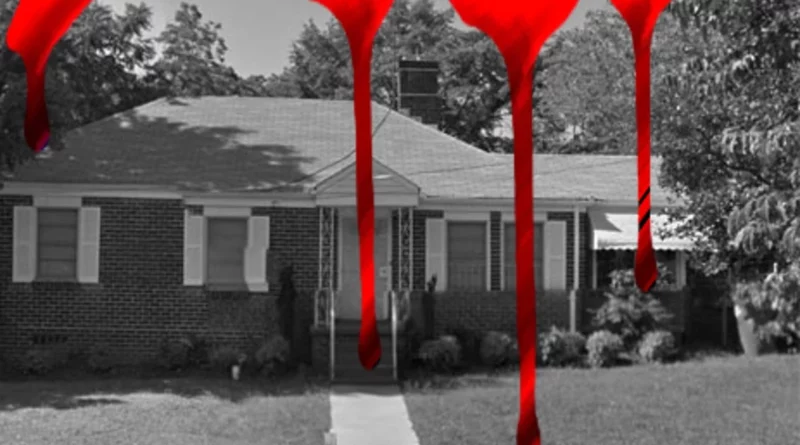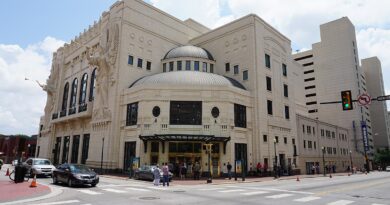The Bleeding House in Atlanta Georgia
On the night of September 8, 1987, a chilling event unfolded at a modest red-brick home on the corner of Fountain Drive and Morris Street in southwest Atlanta, Georgia. Minnie Winston, a 77-year-old resident, was stepping out of the shower when she noticed strange red splotches on the bathroom floor. Alarmed by the sight, she rushed to wake her 79-year-old husband, William Winston, who was resting in bed, connected to a dialysis machine. Minnie exclaimed, “Come look at all this red stuff coming out of the floor.”
The couple’s confusion soon turned into sheer horror as they discovered that the mysterious blood-like substance was not limited to the bathroom—it was spread throughout the house. Blood spots, varying from dime-sized dots to silver dollar-sized patches, were found in the bedroom, kitchen, basement, and even in narrow crawl spaces. Despite William Winston’s medical condition requiring dialysis, the couple adamantly denied any possibility of the blood being theirs.
Initial Investigation and Discovery
Homicide detectives arrived at the scene shortly after the Winstons reported the incident. Detective Steve Cartwright, with ten years of experience on the Atlanta police force, was left bewildered. “I’ve never seen anything like this,” he admitted, calling it an “extremely strange situation.” Another officer, Detective Richard Price, initially speculated that it might have come from an animal, yet the Winstons had no pets, and there were no signs of rodents in the house.
By September 11, forensic analysis identified the blood type as O, while both William and Minnie had Type A blood. This revelation only deepened the mystery and ruled out the couple as the source. The investigation’s early missteps also drew criticism, particularly for the delay in informing the State Crime Lab and the decision to send the blood samples to a local hospital before further analysis.
The house was promptly designated a crime scene to deter the influx of curious onlookers who flocked to witness the bizarre occurrence. Crowds grew so large that law enforcement had to keep a constant presence around the property. Despite the intrigue, investigators struggled to find logical explanations for how or why human blood would manifest in such odd places, including beneath furniture and inside tight crawl spaces.
Media Frenzy and Public Reactions
News of the “bleeding house” quickly spread beyond Atlanta, reaching audiences as far as California and New York. Local media, including the Atlanta Journal-Constitution, were flooded with calls. Radio stations and television networks also faced a surge of inquiries, with many people doubting the veracity of the reports. Some callers even suggested that it might be an elaborate prank or hoax. Others, including psychics, claimed they could help cleanse the house of its supernatural presence.
The Winstons, who had been married for 44 years and had lived in the house for 22 years, found themselves at the center of an unwanted media circus. By September 10, Minnie Winston was fed up with the incessant phone calls and curious strangers. “I’m tired of all these people asking me questions,” she declared. William Winston also grew increasingly agitated, denying the existence of any blood and demanding privacy.
The public’s fascination with the case continued for several days, fueled by the mysterious circumstances and lack of tangible evidence. Some visitors attempted to gain access to the house, prompting Minnie to shout, “What they’ve said about all this is lies. Just leave us alone.” The couple’s frustration and refusal to engage with the media only added to the growing aura of mystery surrounding the event.
Forensic Analysis and Unsolved Questions
The State Crime Lab, under the direction of Larry Howard, examined the samples but found little of significance. The lab determined that the blood appeared to have been “projected” or “shaken off” an unknown object, but the origin and method of projection remained unknown. Further analysis could have revealed more details, such as the sex or race of the blood’s source, had the samples been collected sooner. However, with delays in evidence gathering, critical opportunities were lost, leaving detectives unable to reach a solid conclusion.
With no signs of foul play, deliberate tampering, or logical scientific explanation, law enforcement was left empty-handed. Lieutenant Horace Walker, Homicide Commander at the time, summed up the situation: “If we find that no crime was committed, we’re through with it.” Despite their efforts, investigators were unable to classify the event as either a crime, accident, or hoax.
The bizarre nature of the case led to numerous theories—some mundane, others paranormal. Among the theories floated by locals were supernatural phenomena, underground leaks of unknown substances, and even past crimes manifesting through residual energy. However, none of these theories were substantiated with any concrete evidence.
Theories and Speculations
From the very beginning, one of the most prominent theories regarding Atlanta’s “Bleeding House” was that it was the result of paranormal activity. The discovery of blood in unusual locations, such as crawl spaces and under heavy furniture, seemed to defy logical explanation. Given the absence of any known source for the blood, the case quickly attracted interest from paranormal investigators, psychics, and those who believed in the supernatural.
Other theories explained the circumstance as being a hoax, psychological mishap, caused by environmental or scientific reasons. It’s been proven by the State Crime Lab that the blood was real, type-O and human blood, therefore it’s difficult to believe that the blood was fake, imaginary or came from an animal.
Poltergeist Phenomenon
Some speculators suggested that the bleeding was caused by a poltergeist, a type of spirit believed to cause physical disturbances. Poltergeists are often associated with unexplained noises, moving objects, and in some extreme cases, physical manifestations of substances like water, oil, or even blood. Proponents of this theory argue that the erratic and scattered placement of the blood spots—found in places like under the television and in narrow, hard-to-reach corners—was consistent with the kind of mischief attributed to poltergeists. The fact that the blood appeared suddenly, without any warning or natural cause, also aligns with poltergeist lore.
Residual Energy of Past Events
Another paranormal explanation centers around the concept of “residual energy.” According to this theory, violent events or traumatic incidents that occurred in a location can leave behind residual energy, which may manifest as physical phenomena. Those who support this idea speculate that the house could have been the site of past violent acts, possibly dating back decades. This trapped energy might have caused the sudden appearance of blood-like splotches as a sort of “echo” from the past. However, no known historical records indicate violent events at the specific location of the Winstons’ home, leaving this theory as purely speculative.
Motivations for a Hoax
Despite the seemingly genuine shock of Minnie and William Winston, some have suggested that the bleeding house might have been an elaborate hoax. Skeptics argue that while the Winstons appeared distressed by the sudden appearance of blood, there is a possibility that someone else was responsible for staging the phenomenon, perhaps as a prank or to attract media attention.
While Minnie and William Winston had no known reason to orchestrate such an event, some skeptics believe that external actors could have had motives for faking the blood. These could range from a disgruntled acquaintance seeking revenge, to someone wanting to create a sensation for personal gain. However, this theory is weakened by the lack of evidence indicating tampering or staging at the scene. Additionally, the Winstons themselves were elderly and in ill health—factors that make it unlikely they would engage in such elaborate trickery.
Accidental Contamination
A related theory is that the bleeding could have been the result of accidental contamination, such as leakage from a medical facility or a nearby source of animal blood. William Winston, who was on dialysis, became an early suspect in this regard, as some speculated that a malfunction in his equipment could have caused the spread of blood around the house. However, this theory was debunked when tests showed that the blood type was O, while both William and Minnie Winston had Type A blood. Furthermore, the blood was found in places where accidental contamination seemed improbable, such as crawl spaces and the lower parts of walls.
Psychological Factors
Psychological theories have also emerged to explain the events at the bleeding house. These theories suggest that the Winstons, and even some investigators, could have fallen prey to the power of suggestion. In highly stressful or shocking situations, people sometimes report seeing things that align with their fears or expectations, even if they aren’t actually present.
Mass Hysteria
Mass hysteria, or shared delusion among multiple people, is a rare but documented phenomenon that can lead groups of individuals to perceive the same unreal event. In this context, some theorists suggest that the initial reports of blood might have caused a psychological ripple effect, making those who entered the house more likely to see blood spots where none existed. This psychological factor could have amplified the sense of mystery and contributed to the intense media interest. However, this theory doesn’t account for the physical evidence of blood confirmed by police and forensics teams.
False Memories or Misinterpretation
In cases where eyewitnesses are exposed to bizarre events, false memories can also emerge. Given the stress Minnie Winston experienced when she first saw the blood, some psychologists argue that her initial interpretation may have influenced how others perceived the scene. However, this theory falls short in explaining the physical blood samples that were analyzed by the State Crime Lab.
Fungal or Bacterial Growth
One hypothesis is that unusual fungal or bacterial growths could have produced a reddish substance that resembled blood. Certain molds can produce pigments that look like dried blood, and these growths can sometimes appear suddenly, especially in humid or damp environments. However, forensic analysis confirmed that the substance found in the Winston home was indeed human blood, ruling out this theory as a definitive explanation.
Blood Rain Phenomenon
Some theorists have pointed to the rare but documented phenomenon known as “blood rain,” in which rain appears red due to the presence of algae or other microorganisms in the atmosphere. This occurrence is typically limited to outdoor settings, making it an unlikely explanation for the indoor blood spots found throughout the Winstons’ house. Nonetheless, it’s an example of how natural phenomena can sometimes mimic paranormal events.
The Lack of Resolution: Why Is It Still Unexplained?
Despite extensive police investigations, the case of the bleeding house remains unsolved. Over time, several factors have contributed to the enduring mystery of this bizarre event.
Initial Investigation Errors
Criticism has been leveled at the initial handling of the case, particularly the delay in contacting the State Crime Lab. This delay may have resulted in the loss of critical evidence that could have provided more clues about the source of the blood. Additionally, the fact that fresh samples were not collected immediately made it difficult for experts to perform a complete analysis, which could have included determining the sex or race of the blood’s source.
Lack of Follow-Up
As media attention waned and no clear suspects emerged, the case gradually faded from public attention. With no new evidence or leads, investigators had little incentive to pursue the matter further. This lack of follow-up has left lingering doubts about what really happened in the Winstons’ home and whether more conclusive answers could have been found with a more persistent investigation.
Cultural and Social Context
The Winstons’ case unfolded in a predominantly Black neighborhood during a time when social tensions were already heightened in Atlanta. Some believe that racial biases may have contributed to a lack of urgency in the investigation, as similar cases in more affluent areas might have received more sustained attention and resources. The broader social context of the time may have also influenced how the public perceived the story, contributing to a blend of disbelief, curiosity, and skepticism.
Why the Bleeding House Still Captivates
The bleeding house of Atlanta remains an enigma, capturing the public’s imagination long after the Winstons’ home stopped “bleeding.” It represents a case that defies easy categorization, lying at the crossroads of paranormal mystery, psychological phenomena, and potential scientific explanations. For some, it’s a classic ghost story with a chilling twist; for others, it’s a reminder of how quickly sensational tales can spiral out of control in the absence of concrete answers.
Ultimately, the theories and speculations about the bleeding house may never be fully resolved, leaving it as one of Atlanta’s most unsettling urban legends. Whether viewed as a supernatural anomaly, a psychological oddity, or an unsolved scientific riddle, the mystery persists—a haunting question that may forever linger in the annals of bizarre history.
The Legacy of Atlanta’s Blood House
As the investigation dragged on without any clear answers, public interest gradually waned. Like many paranormal mysteries, the “bleeding house” faded into local legend. Without scientific evidence or clear motives, the case was quietly closed, with no official resolution or explanation. Crime Lab Director Larry Howard expressed disappointment at the lack of conclusive results: “It troubles me that we don’t have any answer.” This sentiment echoed among law enforcement personnel who had hoped to solve the enigma.
Despite the case’s unresolved nature, it remains a well-known story in Atlanta’s folklore, representing one of the most baffling unsolved mysteries in the city’s history. Residents who lived through that era still recall the shock and intrigue it generated. For the Winstons, the experience was deeply disturbing. By the time the media frenzy ended, they were simply relieved to be left alone. For everyone else, the mystery remains—a symbol of the eerie and inexplicable events that occasionally defy scientific analysis.
A Lingering Enigma
More than three decades have passed since the events at the Blood House in Atlanta, yet the mystery remains unsolved. No other similar cases have occurred in the area, and the story stands as a peculiar example of the unexplainable events that sometimes disrupt ordinary life. Paranormal investigators and enthusiasts continue to reference the Blood House case when discussing unsolved mysteries that blur the line between science and the supernatural.
While the house itself no longer draws the crowds it once did, it remains a topic of intrigue for those fascinated by Atlanta’s history of unsolved crimes and paranormal occurrences. For the Winstons, the events of September 8, 1987, were a frightening chapter they wished to forget, but for many others, it continues to be an unsolved puzzle—a lingering question that may never be fully answered.
Discover more from City Towner
Subscribe to get the latest posts sent to your email.




